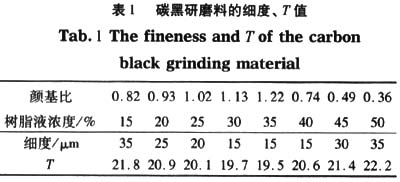2.2.3 Abrasive Performance Testing In actual ink manufacturing, the end point of the dispersion is often terminated to achieve the desired performance criteria, such as: fineness, hiding power, tinting strength, etc., in which the fineness is generally referred to as the index "4" of the central control and final control. In this experiment, the fineness and dispersion stability of the abrasives were tested. Fineness According to the national standard GB/T13217.3-91 test "5", using 0-50xm scale QxD scraper fineness meter. Dispersion stability of the test "6", take 20Ml grinding material into a test tube, after standing for 24h at about 1Cm below the liquid surface to draw 0.5mL, diluted with 8mL of distilled water, using a CARY-50 spectrophotometer (into Light transmittance (T%) was measured to characterize the dispersion stability. When using sedimentation experiments to determine the effect of the dispersion stability of the dispersion system, the greater the T value, the smaller the optical density of the dispersion system, the more free sedimentation of the pigment particles, the more unstable the dispersion system; the smaller the T value, the greater the optical density of the dispersion system. The pigment particles have less free sedimentation and the dispersion system is stable. The measured data for the fineness and dispersion stability (T%) of each pigment mill are shown in Table 1-6. 1) Through the analysis of the fineness and dispersion stability data of the grinding material, it can be concluded that the maximum pigment base ratio of the pigment and the resin is determined by applying the Daniel flow point method, and the milled abrasive index conforms to the production of the aqueous ink. Requirements, in the production of water-based ink can effectively improve the efficiency of pigment dispersion machinery. 2) The range of maximum pigment base ratio of the six pigments in the millbase can be determined from Fig. 1, see Table 7. Among them, waterborne resins are most difficult to disperse carbon black, because carbon black has a large specific surface area, a high HLB value (hydrophobicity), and a strong agglomeration force between particles to form aggregates; followed by organic pigments, especially the red pigment. The dispersion of the material; the dispersion of titanium dioxide is the easiest. 4 Conclusion In summary, the use of Daniel's flow point method in the production of water-based inks to determine the maximum base ratio of the abrasive, not only can significantly improve the work efficiency of the pigment dispersing machinery, save production costs, but also is a simple, fast method, shorten The production cycle, which fully demonstrates the practicality of Daniel's flow point technology. Stainless Steel Bottle
Stainless Steel Bottles are made from high-grade 18/8 stainless steel. This material is food grade, non-toxic, durable and easy to clean.
And we got a lot of different kinds of Stainless Steel Bottles. For example: Stainless Steel Cola Bottle, a classic design that is popular in the market and easy to use, also looks good. Speaking of looking, our Cola Bottle comes in changeable colors and diverse patterns.
Stainless Steel Bullet Shape Bottle has another classic design of body shape. This makes the bottle look straight and smooth.
Our Stainless Steel Bottles are mostly Stainless Steel Vacuum Water Bottles. They have a double-wall vacuum treatment, so they can ensure your drink keeps as it is. And you don't need to worry about getting your hands cold or hot.
Stainless Steel Single Wall Bottle has a single wall. It sacrifices thermal insulation and improves portability. Holding it in your hand all the time will not cause any discomfort.






3 results 
(Text / Zhang Qixin Xiu Lan Xiaoyang Beijing Technology and Business University)
"Packaging Project"
Stainless Steel Bottle,Stainless Steel Shaker Bottle,Stainless Steel Bottle 304,Stainless Steel Solid Color Bottle
Ningbo Auland International Co.,Ltd. , https://www.aulandbottles.com